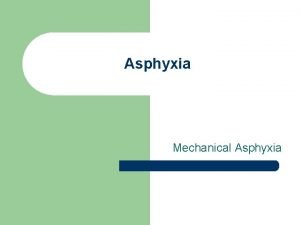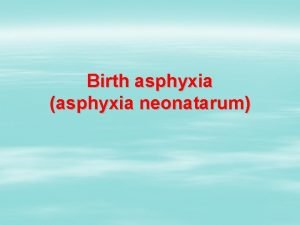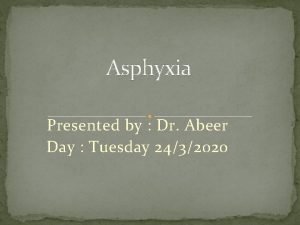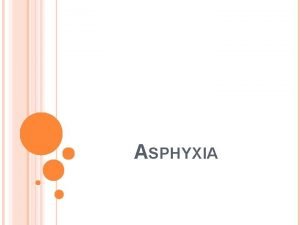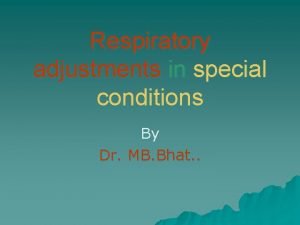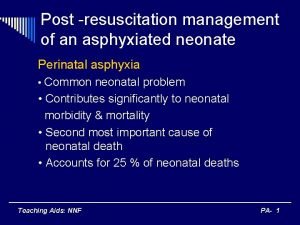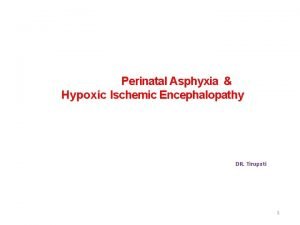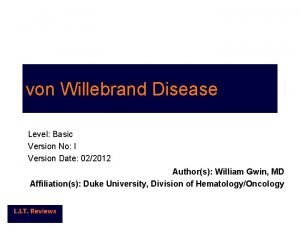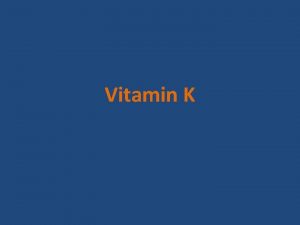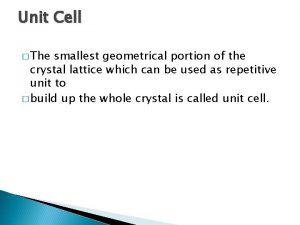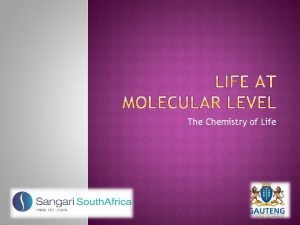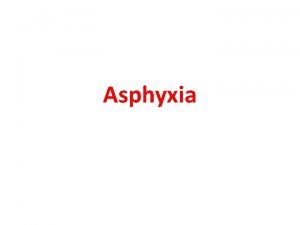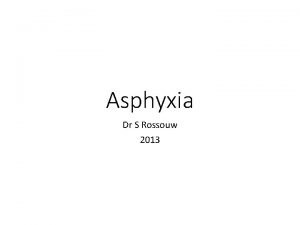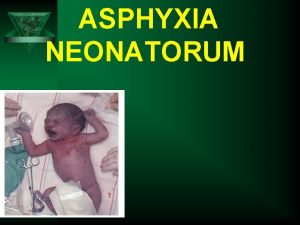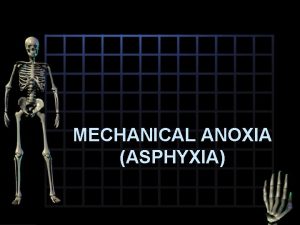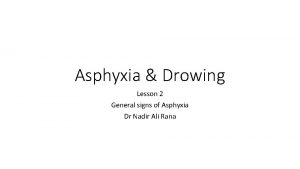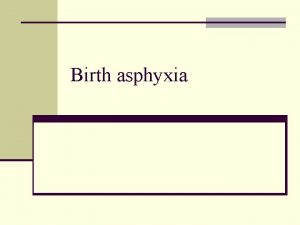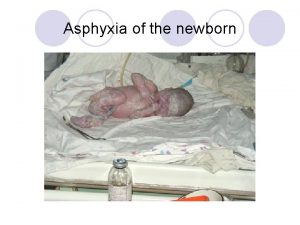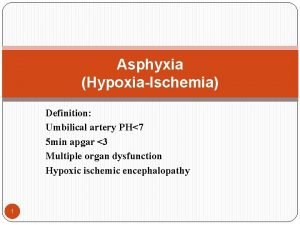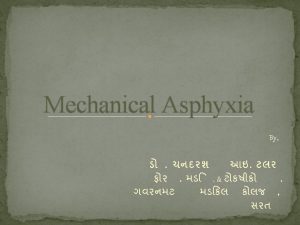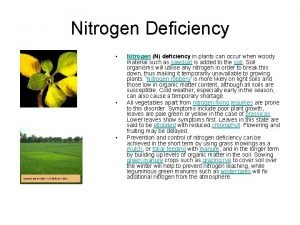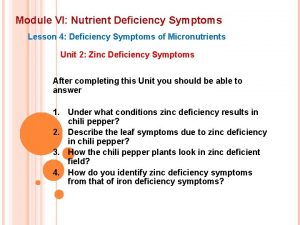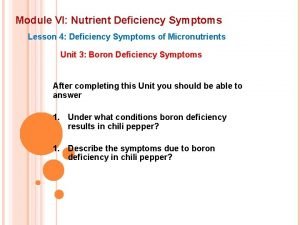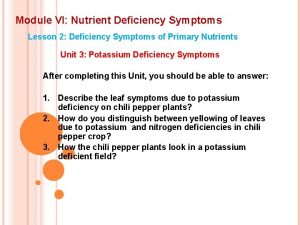Asphyxia Definition It is the deficiency of O



























































- Slides: 59


Asphyxia Definition: It is the deficiency of O 2 supply to tissues below the physiological level or inability of the tissues to utilize O 2. Degree: 1. 2. Hypoxia Anoxia. Classification ( Types or causes ) of Asphyxia: It depends on the affected element of respiration.

Elements of Respiration l l l Air passages and lung tissue. Respiratory center. Respiratory muscles. Blood. Respiratory enzymes.

(1) Mechanical Asphyxia Due to closure of Respiratory Passages and/or lung alveoli. Mechanical Asphyxia Pathological M. A. Violent M. A.

A. Pathological M. A. l Edema of the glottis or lung. l Hemorrhage in the lung. l Tumor in air passages or lung tissue. l Inflammation ( bronchitis or pneumonia ).

B. Violent M. A. Smothering. l Throttling (Manual strangulation). l Strangulation (ligature strangulation). l Hanging. l Drowning. l Choking: 1 - Vomit 2 - Blood 3 - Foreign body 4 - Faulty administration l l Traumatic 1 - Burking A: 2 - Overlaying

(Damage n (2) Central Asphyxia or inhibition of Respiratory center). Causes: morphine, datura, hypnotics, barbiturate, uremia, brain compression, and electric shock. (3) Suffocative (Environ. , Entrapment) A. n Decrease O 2 level in air and increase CO 2 or Nitrogen O 2 (20. 9%) less than (10%). (4) Paralytic A. n n Due to Paralysis of Respiratory muscles Cause: Strychnine , Succinylcholine. OPC

(5) Static ( Stagnant ) A. n Due to interference with blood flow n Causes: 1. 2. 3. Heart failure (Digitalis , Aconite) Hemorrhage (Hematogenic shock) Histamine ( Toxemic shock ) (6) Anaemic A. n n Hb unable to combined with O 2 Causes: CO and Nitrite (7) Hemolytic A. n Due to hemolytic of RBCs n Causes: Snake venom , Zinc phosphide , Arsine gas. (8) Histotoxic (Cytotoxic or Tissue ) A. n n Due to inhibition of tissue Resp. enzymes Cause: Cyanide toxicity.

Stages ( Clinical Signs ) of Asphyxia Dyspnea stage l Convulsion stage l Paralytic stage General ( picture ) Marks of Asphyxia l Pathogenesis l

(1) External Marks l Cyanosis l Bulging eyes l Froth l Dark blue hypostasis l (Exception CO & Cyanide

(2) Internal Marks l Congestion of lung & internal viscera. l Petechial hemorrhage (Sub pleura = Tardieu spots) l Froth in the air passages. l Silver spots (ruptured alveoli under pleural surface). l Dark fluid blood.

Special Marks Smothering: l (contusion & abrasions around the mouth and nostrils) Throttling: contusion & nail abrasion (neck ) l Fracture of hyoid bone and thyroid & cricoid cartilage Cause of death: l 1. 2. 3. obstruction of air passages cerebral anemia (carotid arteries ) shock ( pressure on carotid plexus )


Smothering: Cause of asphyxia: Mainly due to mechanical l obstruction or occlusion of the respiratory orifices (nose and mouth). Mainly homicidal.


3 - Choking: Cause of asphyxia: obstruction within the air passages


Choking may be: Natural Accidental (mainly) Acute inflammation of epiglottis. Café coronary. Rubber ball, button Screw, balloons…. Homicidal


Suffocating gases: Cause of asphyxia: deaths from suffocating gases are l not due to the toxic nature of the gases, but due to displacement of oxygen from the atmosphere. The most common suffocating gases are carbon dioxide and methane.


Strangulation: Strangulation is a form of asphyxia l characterized by closure of the blood vessels and air passages at the neck region resulted fro external pressure in the neck. Cause of death from suffocation: cerebral hypoxia

A-Hanging: Cause of asphyxia: Compression and constriction of the l neck structures by a nose or other constricting bands tightened by the body weight. They may be complete or incomplete l suspension of the body.

Special Marks Strangulation: l l Rope mark Contusion and laceration of neck tissues Protrusion of eyes Fracture of thyroid ( laryngeal and tracheal cartilages) Causes of death: 1. 2. 3. Obstruction of air passages Cerebral anemia Neurogenic shock


B-ligature strangulation: Cause of asphyxia: Compression and constriction of l the neck structures by constricting bands tightened by a force other than the body weight. Mainly homicidal.


C-Manual strangulation: Cause of asphyxia: Pressure of the hand forearm or l other limb against the neck compressing the internal structures of the neck. Mainly homicidal.


Chemical asphyxia: Cause of asphyxia: inhalation of toxic chemical l substances which prevent utilization of oxygen at the cellular level.


1 - Hydrogen cyanide and its salts (potassium and sodium cyanide) Cyanide salts are harmless until l contact with hydrogen (from HCl or H 2 O in stomach) producing hydrogen cyanide gase. There is no cumulative effect. l


Mode of action: Once free cyanide is absorbed it l reacts with ferric iron (+3) in Cytochrome oxidase which halts cellular respiration. Oxyhemoglobin cannot release oxygen for electron transport in the cytochrome system since the cyanide – cytochrome oxidase will not function in electron transport.




Clinical signs: Animals are commonly found dead due § to rapidity of cyanide’s effects When observed, signs may include § excitement, general muscle tremors, dyspnea, salivation, defecation, urination followed by colonic convulsions and death.


P. M. findings: Bright red color to blood and mucous membranes. (red asphyxia)


2 - hydrogen sulfide (H 2 S) sewer gase: Mode of action: in low concentration: q Act as severe local irritant In high concentrations: q Reduction of Oxyhemoglobin and formation of met hemoglobin


P. M. findings: Cyanosis with dark colored blood l


Normal venous blood met hemoglobin


3 - carbon monoxide Co: Mode of action: transformation of l Oxyhemoglobin carboxyhemoglobin preventing transport of oxygen.

3 - carbon monoxide Co: Mode of action: transformation of l Oxyhemoglobin carboxyhemoglobin preventing transport of oxygen.


P. M. findings: Cherry red (bright red) coloration l of the blood

Special marks of asphyxia 1 - Smothering: -Contusion & abrasions around the mouth 2 - mechanical and violent asphyxia: - Abrasions, contusions & lacerations allover the body - Fracture of the ribs may be present - In severe cases ---- lacerations of the lung & internal tissues

hanging: Rope mark • Abrasion & lacerations of neck tissue • Pale face, black protruded tongue • Fracture of laryngeal and tracheal • cartilages ligature strangulation: ligature furrow (ligature mark on the neck • Fracture of the hyoid bone, thyroid • cartilage Hemorrhage into the neck muscles •

Manual strangulation: Nail mark • The face is congested, cyanotic with petichea in the conjunctiva and sclera 6 - hydrogen cyanide: Red asphyxia • 7 - carbon monoxide: Cherry red (bright red) coloration of the blood • 8 - hydrogen sulfide: Cyanosis with dark colored blood • •

Special Marks Hanging: l l Rope mark ( incomplete ) Fracture of hyoid bone ( common ) Hypostasis Fracture of odentiod process Causes of death: 1. 2. 3. 4. Closure of gullet by the base of the tongue Cerebral anemia Neurogenic shock Tearing of medulla oblongata

Special Marks Traumatic A. : l Abrasion , contusion & laceration of body ) l Fracture of ribs l Contusion & laceration of intercostals m.

Drowning l l l l - Froth (large amount, white & fine, odorless) - Water filled stomach & lung - Planktons & Diatoms in lung, stomach, blood and internal organs. - Hypostasis - Cadaveric spasm - Chloride percentage (Fresh or salt water) - Gettler test

Gettler test "depends on the assumption that, in persons drowning in sea water, the inhalation of highly saline water will lead to an increased blood chloride concentration in the left heart as compared to the right and, in persons drowning in fresh water, a dilution of blood chlorides in the left heart as compared to the right. "

Thank you
 Positional asphyxia positions
Positional asphyxia positions Lll engorgement
Lll engorgement Questions on asphyxia
Questions on asphyxia Classification of birth asphyxia
Classification of birth asphyxia Neonatarum
Neonatarum Silvery spots in asphyxia
Silvery spots in asphyxia Silvery spots in asphyxia
Silvery spots in asphyxia Beclotide inhaler
Beclotide inhaler Stages of asphyxia
Stages of asphyxia Management of asphyxia neonatorum after resuscitation
Management of asphyxia neonatorum after resuscitation Levene staging
Levene staging Hyponuria
Hyponuria Hình ảnh bộ gõ cơ thể búng tay
Hình ảnh bộ gõ cơ thể búng tay Bổ thể
Bổ thể Tỉ lệ cơ thể trẻ em
Tỉ lệ cơ thể trẻ em Gấu đi như thế nào
Gấu đi như thế nào Glasgow thang điểm
Glasgow thang điểm Hát lên người ơi alleluia
Hát lên người ơi alleluia Môn thể thao bắt đầu bằng chữ đua
Môn thể thao bắt đầu bằng chữ đua Thế nào là hệ số cao nhất
Thế nào là hệ số cao nhất Các châu lục và đại dương trên thế giới
Các châu lục và đại dương trên thế giới Công của trọng lực
Công của trọng lực Trời xanh đây là của chúng ta thể thơ
Trời xanh đây là của chúng ta thể thơ Cách giải mật thư tọa độ
Cách giải mật thư tọa độ Phép trừ bù
Phép trừ bù độ dài liên kết
độ dài liên kết Các châu lục và đại dương trên thế giới
Các châu lục và đại dương trên thế giới Thơ thất ngôn tứ tuyệt đường luật
Thơ thất ngôn tứ tuyệt đường luật Quá trình desamine hóa có thể tạo ra
Quá trình desamine hóa có thể tạo ra Một số thể thơ truyền thống
Một số thể thơ truyền thống Cái miệng nó xinh thế
Cái miệng nó xinh thế Vẽ hình chiếu vuông góc của vật thể sau
Vẽ hình chiếu vuông góc của vật thể sau Nguyên nhân của sự mỏi cơ sinh 8
Nguyên nhân của sự mỏi cơ sinh 8 đặc điểm cơ thể của người tối cổ
đặc điểm cơ thể của người tối cổ Thế nào là giọng cùng tên?
Thế nào là giọng cùng tên? Vẽ hình chiếu đứng bằng cạnh của vật thể
Vẽ hình chiếu đứng bằng cạnh của vật thể Phối cảnh
Phối cảnh Thẻ vin
Thẻ vin đại từ thay thế
đại từ thay thế điện thế nghỉ
điện thế nghỉ Tư thế ngồi viết
Tư thế ngồi viết Diễn thế sinh thái là
Diễn thế sinh thái là Dot
Dot Số.nguyên tố
Số.nguyên tố Tư thế ngồi viết
Tư thế ngồi viết Lời thề hippocrates
Lời thề hippocrates Thiếu nhi thế giới liên hoan
Thiếu nhi thế giới liên hoan ưu thế lai là gì
ưu thế lai là gì Hổ đẻ mỗi lứa mấy con
Hổ đẻ mỗi lứa mấy con Sự nuôi và dạy con của hươu
Sự nuôi và dạy con của hươu Hệ hô hấp
Hệ hô hấp Từ ngữ thể hiện lòng nhân hậu
Từ ngữ thể hiện lòng nhân hậu Thế nào là mạng điện lắp đặt kiểu nổi
Thế nào là mạng điện lắp đặt kiểu nổi Vwf deficiency labs
Vwf deficiency labs Vitamin k and pt
Vitamin k and pt Pantothenic acid deficiency
Pantothenic acid deficiency Difference between frenkel defect and schottky defect
Difference between frenkel defect and schottky defect Queseease
Queseease Chemistry of life summary
Chemistry of life summary

